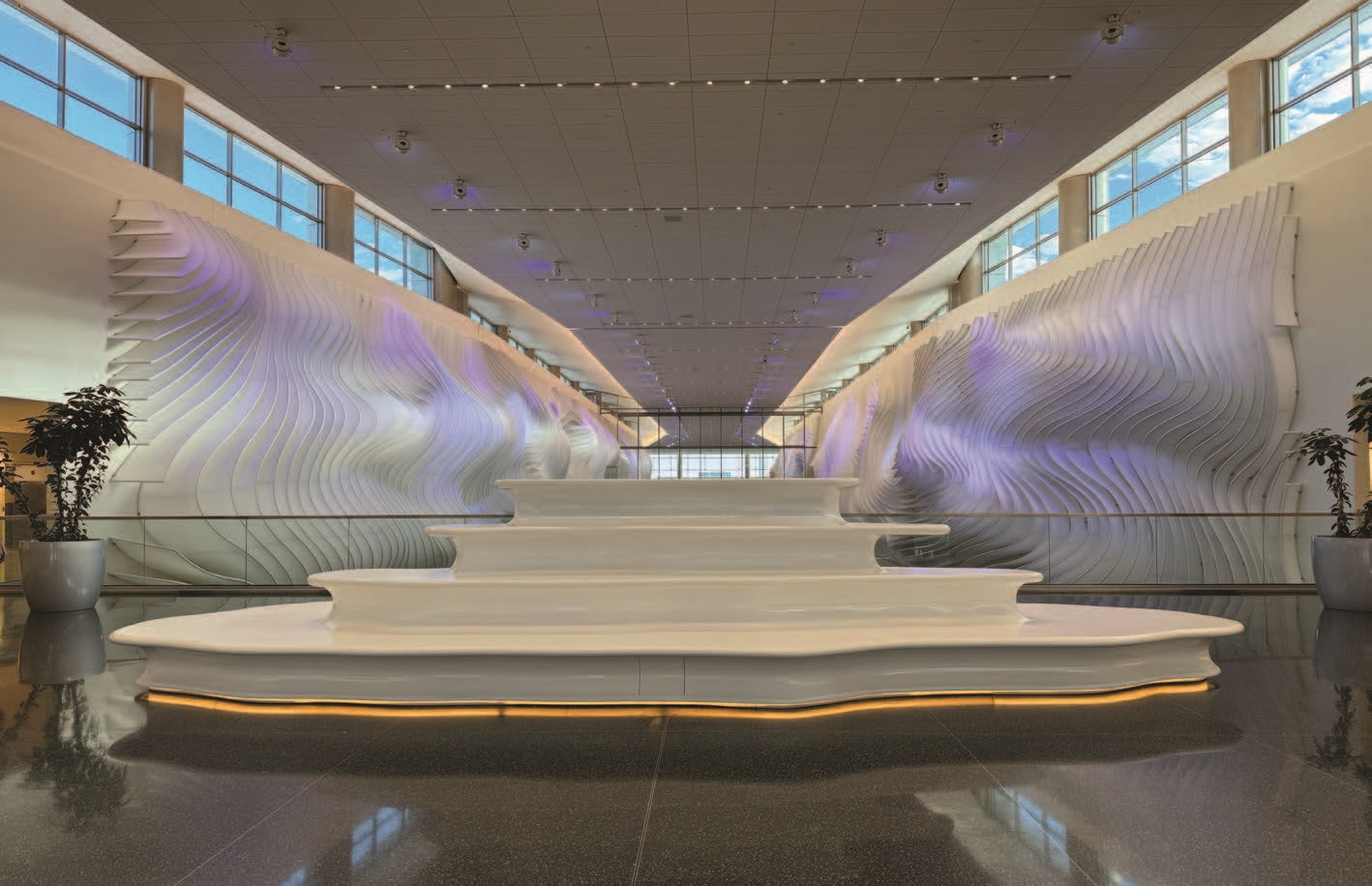Driving from Salt Lake City into the Uinta Basin in northeastern Utah, the route explodes with long bursts of visible layers of deposition—eye candy to geologists and the untrained alike, the latter not knowing exactly what they’re looking at but certain it is significant.
A taste of what’s to come is upon arrival at the Salt Lake City airport upon exiting the security-cleared side into a long hall with a wall covering that protrudes, creating a water-sculpted canyon cave.
Seating is in the form of stratigraphically layered mesas that beg to be climbed—and some visitors likely have, but quickly before being told to climb down.

South and east of Heber City, cell service, thus any streaming music or GPS service, will be lost for about 40 minutes of silence as entertainment turns solely to witnessing verdant mountainsides and green plains that give way to what was once an ancient lake bed: the Uinta Basin.
The roadside outcrops are brilliant red, orange, peach, a pale tan or yellow, depending on composition and, as photographers will find, the time of day. To find that spectacular crimson feature somewhere west of Duchesne again is quixotic.
Suddenly the land flattens again into an arid plain with intermittent pockets of irrigated land, fed by the Strawberry River that drains into the Duchesne, then the Green River and eventually the Colorado.
Cattle graze, while their owners tend hay and alfalfa crops, rebuilding the winter stock.
And man-made outcrops begin to appear.
Drilling rigs, workover rigs, pumpjacks, man camps, oil-tank batteries and frac spreads are within easy sight of a motorist with nothing to block them from view. That is, nothing except for oil-hauling trucks delivering to Salt Lake City or south to a rail terminal, or dead-heading back to the pads to empty another batch of tanks.
The Hideout steakhouse appears off to the right on Monument Butte just before reaching Myton and comes with an obvious recommendation: the lot is filled with oilfield trucks—every day and every evening.
There, customers can choose to go ancient: You can cook your steak yourself on a hot rock at the table. (Warning: Choosing this option may result in bragging.)
Whether you or the kitchen cooks it, the steak will be one of the best one has ever had and accompanied by sauteed vegetables that are melt-in-the-mouth down to the very last (whole and fresh, not canned) green bean.
Underneath the Hideout is the southwestern end of the Eocene-epoch Green River Formation that has been cooking organic matter into oil for 60 million years.
Laid down while the basin was a lake, the deepest member, the Uteland Butte, features tight carbonate reservoirs at between 4,000 ft and 6,000 ft in the area.
Within it are two layers of shale with three dolomitic members in between ranging in thickness of 1.5 ft to 8 ft and having up to 30% porosity but 0.1 millidarcy or less of permeability, according to the Utah Geological Survey.
While the potential for stimulated horizontal application in the Uinta has been known for two decades, there are figurative outcrops in the basin that have delayed the rollout.
One is the waxy nature of Uinta crude and the market. Until the growth of a rail option in the past few years, the only economic place to send Uinta oil was Salt Lake City’s five refineries.
Waxy oil has to be heated in the field and carried in insulated trucks rather than pipelines or the wax will solidify. Also, it has to be cracked and the nearby refineries’ cracking capacity is less than 100,000 bbl/d.
A figurative outcrop that has cast a pall on the basin recently is a new one: the Federal Trade Commission (FTC). The nearby refineries’ economics depend on the waxy crude. An E&P wanting to build scale via M&A among the roughly half-dozen sizable drillers today could have too much command of Uinta supply, the FTC has theorized.
Recently, Uinta operator XCL Resources, which was already prevented in 2022 by the FTC from buying out EP Energy in the basin, wanted to buy neighbor Altamont Energy, which has mostly undeveloped leasehold.
Rather than continue to pursue FTC approval, XCL decided to simply sell itself to SM Energy, a new Uinta entrant, which then also bought Altamont.
A basin operator told Oil and Gas Investor, “The FTC took it too far when they got involved in this Altamont deal: It’s a very small deal. It didn’t make sense for them to make an issue out of that.”
RELATED
Now, the Uinta: Drillers are Taking Utah’s Oily Stacked Pay Horizontal, at Last
Recommended Reading
BKV Positions Itself to Meet Growing Power, CCS Demand
2025-02-26 - Electricity needs across the U.S. are expected to soar as industrial and manufacturing facilities, data centers and other consumers crave more power. BKV is exploring ways to bridge the gap between demand and energy supply.
E&P Highlights: Jan. 21, 2025
2025-01-21 - Here’s a roundup of the latest E&P headlines, with Flowserve getting a contract from ADNOC and a couple of offshore oil and gas discoveries.
Baker Hughes, Frontier Form CCS, Powergen Partnership
2025-03-03 - Baker Hughes will provide technology solutions to support the Sweetwater Carbon Storage Hub being developed by Frontier Infrastructure in Wyoming.
ADNOC Contracts Flowserve to Supply Tech for CCS, EOR Project
2025-01-14 - Abu Dhabi National Oil Co. has contracted Flowserve Corp. for the supply of dry gas seal systems for EOR and a carbon capture project at its Habshan facility in the Middle East.
Diversified, Partners to Supply Electricity to Data Centers
2025-03-10 - Diversified Energy Co., FuelCell Energy Inc. and TESIAC will create an acquisition and development company focused on delivering reliable, cost efficient net-zero power from natural gas and captured coal mine methane.
Comments
Add new comment
This conversation is moderated according to Hart Energy community rules. Please read the rules before joining the discussion. If you’re experiencing any technical problems, please contact our customer care team.






